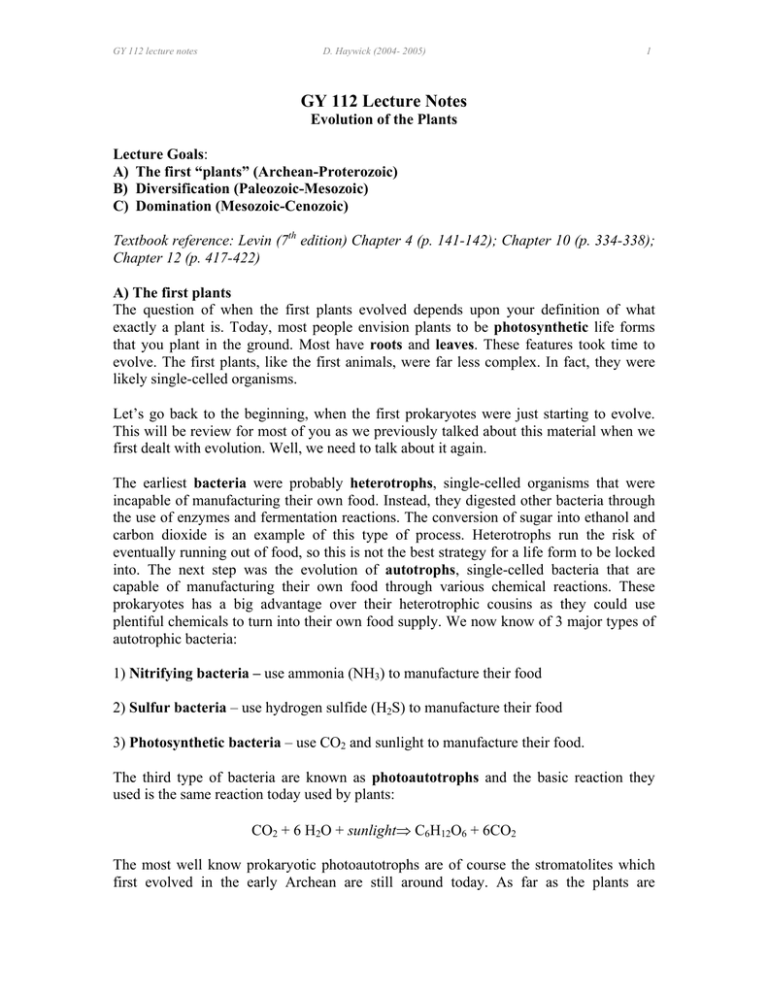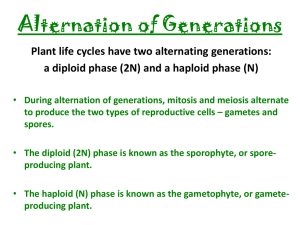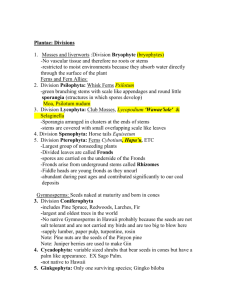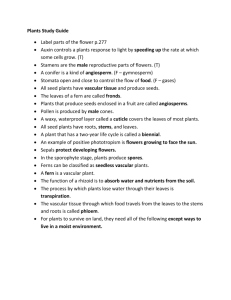Document 11267412
advertisement

GY 112 lecture notes D. Haywick (2004- 2005) 1 GY 112 Lecture Notes Evolution of the Plants Lecture Goals: A) The first “plants” (Archean-Proterozoic) B) Diversification (Paleozoic-Mesozoic) C) Domination (Mesozoic-Cenozoic) Textbook reference: Levin (7th edition) Chapter 4 (p. 141-142); Chapter 10 (p. 334-338); Chapter 12 (p. 417-422) A) The first plants The question of when the first plants evolved depends upon your definition of what exactly a plant is. Today, most people envision plants to be photosynthetic life forms that you plant in the ground. Most have roots and leaves. These features took time to evolve. The first plants, like the first animals, were far less complex. In fact, they were likely single-celled organisms. Let’s go back to the beginning, when the first prokaryotes were just starting to evolve. This will be review for most of you as we previously talked about this material when we first dealt with evolution. Well, we need to talk about it again. The earliest bacteria were probably heterotrophs, single-celled organisms that were incapable of manufacturing their own food. Instead, they digested other bacteria through the use of enzymes and fermentation reactions. The conversion of sugar into ethanol and carbon dioxide is an example of this type of process. Heterotrophs run the risk of eventually running out of food, so this is not the best strategy for a life form to be locked into. The next step was the evolution of autotrophs, single-celled bacteria that are capable of manufacturing their own food through various chemical reactions. These prokaryotes has a big advantage over their heterotrophic cousins as they could use plentiful chemicals to turn into their own food supply. We now know of 3 major types of autotrophic bacteria: 1) Nitrifying bacteria – use ammonia (NH3) to manufacture their food 2) Sulfur bacteria – use hydrogen sulfide (H2S) to manufacture their food 3) Photosynthetic bacteria – use CO2 and sunlight to manufacture their food. The third type of bacteria are known as photoautotrophs and the basic reaction they used is the same reaction today used by plants: CO2 + 6 H2O + sunlight⇒ C6H12O6 + 6CO2 The most well know prokaryotic photoautotrophs are of course the stromatolites which first evolved in the early Archean are still around today. As far as the plants are GY 112 lecture notes D. Haywick (2004- 2005) 2 concerned, the next major development probably occurred simultaneously with evolution of eukaryotes. This, as I’m sure you all remember, was the development of larger cells with enclosed nuclei that propagated through sexual reproduction. The most accepted hypothesis for this development is that one prokaryote assimilated another without actually digesting it. Perhaps this was a symbiotic relationship at first, but overtime, the assimilated prokaryote developed into a nucleus and the assimilating prokaryote became the enclosing cell and was contained within a membrane. Those eukaryotes containing an assimilated photoautotroph are likely the ancient ancestors of the plants. The first photosynthetic eukaryotes were the chorophytes which today include green algae. They would likely have developed in the shallow oceans, like the stromatolites. Eventually these algae would have begun to populated terrestrial lakes and streams, but when this occurred is very difficult to determine. Green algae do not fossilize particularly well. Like the animals, for plants to fossilize, they need to have parts that can be preserved in the rock record. This did not really occur until the Paleozoic. B) Diversification (Paleozoic) The first fossilized plants were found in late Silurian sedimentary rocks, and as far as plants go, they were pretty unimpressive. They were small (maybe 5 cm high) and had very few features that you would today associate with plants growing in your back yard. No leaves, no branches, not even true roots. Yet they were far more advanced than the chorophytes that they were derived from. These plants were metazoans (multicellular) and looked something like this species, Cooksonia sp.: The major evolutionary advance that these plants had was a vascular stem. Vascular plants are called Tracheophytes and are important improvements over non-vascular plants (Bryophytes) as they had porous stems that allowed water to be rapidly moved from the soil throughout the plant. There are still bryophytes today. They include mosses and liverworts. Modern tracheophytes also have roots and leaves, but these features took time to evolve. There were no leaves that we know of in Cooksonia sp., nor were there roots. Instead, Cooksonia sp. had a rhizome from which individual stems sprouted. Reproduction was done through spores which each plant had stored in protected spore pods or sporangia near the tips of the stems. When ripe, they would split spreading spores over a large area. Cooksonia sp. Might have looked like a bunch of wooden match sticks sticking out of the ground. Reproduction through spores is still done by a lot of plants, but it does suffer from one important limitation. Spores need water to reproduce, lots of it, and today, most sporebearing plants live near swampy areas where they can be guaranteed a steady supply of GY 112 lecture notes D. Haywick (2004- 2005) 3 H2O. Once released and in the ground, each spore develops into a tiny root-like structure (prothallus) that lives entirely below ground feeding on rotting substances. This is where the sex cells develop. Male cells develop in the antheridium and female cells develop in the archegonium. Male cells are released into the water and fertilize a single egg within the archegonium repeating the process over and over again. In GY 112 you don’t really have to worry too much about the reproduction of sporeproducing plants. Nor do you have to remember a lot about plant taxonomy which is similar to (but not identical) to the taxonomy that we have already discussed for the animals. Botanists prefer to use Divisions instead of Phyla and in the case of plants like Cooksonia sp., they are classified as members of Division Psilophyta. Most people just call them the psilopsids Another psilopsid was Rhynia sp. which developed in the middle Devonian. There is better evidence of the vascular system in this plant than Cooksonia sp., but the general consensus is that the psilopsids first developed in the late Silurian. From then on, the colonization of the terrestrial environments of the planet began in earnest. Before this time, the land masses were largely devoid of all life forms. No vascular plants, no animals, no insects. Rain fell, rivers flowed, the wind blew, glaciers advanced and retreated and hurricanes and tornados wandered around. But this happened over an empty landscape. Kind of weird wasn’t it? Don’t forget that the oceans were teaming with life by the time the first vascular plants started to develop on land. It was a far better place to live, but once we get to the Devonian, things are really going to change in both the oceans and on the land. The Devonian is known as both the Age of the Fishes and the Age of the Plants. Since this lecture is concentrating on plants, we’ll concentrate on the latter. The next major development of the plants occurred in the early Devonian (perhaps the late Silurian). It was the appearance of leaves. Leaves allow plants to increase the surface area for photosynthesis. Since they are producing their own food with sunlight, the more food you produced, the better off you are. The first leaves were small and developed close to stem of the plants. Sporangia shifted to the underside of the leaves. Plants were also getting much larger and by the middle Devonian, some stood 30 m (100 feet) high. This is another advantage of a vascular system. You can get water up a long way up from the ground. The taller the tree gets, the more sunshine it gets1. The Devonian is known as the age of the plants because of the appearance of a bunch of new plant divisions. Some were really cool like those in division Lycopsida (the lycopsids). This division 1 This has nothing to do with being closer to the sun – if you are taller than your neighbors, you get the sun and they get the shade. Competition in evolution is not just restricted to animals with teeth and claws. GY 112 lecture notes D. Haywick (2004- 2005) 4 includes club mosses and Lycopodium sp. (both living) and extinct scale trees like Lepidodendron sp. which you will see in an upcoming GY 112 lab. Lepidodendron holds a place that is near and dear to my heart. It is the only fossil that I can vividly remember from my intro geology classes back at McMaster University in 1979. I don’t know why. The name is kind of musical and the fossil is noteworthy because of its geometric pattern. Whatever the reason, I will never forget the scale tree from my youth, nor will I forget the significance of the scales – they were actually rudimentary leaves. Another important division of plants that first appeared in the early Devonian was Sphenopsida. The sphenopsids today include the horsetails which are interesting plants that have jointed stems. Extinct trees that you will see in the lab include Calamites sp. and Annularia sp. Both of these plants qualified as trees as they were large, but they still had the same jointed stems that today characterize the horsetails. Needle-like leaves radiated from these joints. Note that they still reproduced by spores. Lepidodendron in the GY 112 lab collection. The sample is about 20 cm wide A cartoon sketch of Calamites, one of the sphenosids that you will see in the lab Western Equisetum, an example of a “horsetail (Source: www.botit.botany.wisc.edu) GY 112 lecture notes D. Haywick (2004- 2005) 5 The next division of plants that evolved in the early Devonian was Pteropsida. The pteropsids are also known as the “true ferns” and are very common on the planet today (especially in my front yard!). These plants got to be tree-sized in the Devonian and in some parts of the world (e.g., temperate rainforests in western Canada and New Zealand), are still many metres high. The true ferns have very well developed leaves that usually radiate from a stem. New leaves extend from the tip of the stem in a coiled roll. In the Maritimes of Canada and some parts of the New England states, the tips of growing ferns are considered a delicacy (see the 2005-2006 lab manual for a recipe for these eatable bits). They are called fiddleheads because they resemble the carved end of violins. The pteropsids propagate from spores that cover the undersides of the leaves The next division that we need to discuss is a big one. Division Pinophyta, generally just called the gymnosperms, consists of 4 major subdivisions or classes: Pteridospermophyta (the seed ferns): range from Devonian to Recent (rare today) Pinopsida (the conifers): range from Mississippian to Recent Cycadopsida (the cycads): range from Triassic to Recent Ginkgopsida (the ginkgos): range from Jurassic/Cretaceous to Recent All 4 classes share one important feature that first appeared during the Devonian; seeds. These seeds are officially considered to be naked (naked seeds) because they were not encased in a fruit. Fruit encases many seeds today (e.g., peaches, apples, grapes), but in the gymnosperms. The closest thing you get are the cones that encase the seeds of pine trees (the conifers). The seed ferns look very much like other ferns except that they have seeds on the underside of their leaf fronds instead of spores. They are GY 112 lecture notes D. Haywick (2004- 2005) 6 relatively rare today. In contrast, the confers are very abundant and include cedars, spruces, pine trees etc. The cycads are a strange group of plants that kind of resemble ferns. The most common one that I am aware of, at least in Mobile, are sago palms. The reproductive element of a sago palm is a light colored central cluster of fronds that almost resembles a flower. However, a flower it is not. Flowers did not evolve until a bit later in the Cretaceous and are such an important feature that plants that produce them are classified in a separate division. The last of the gymnosperms that we need to discuss are the ginkgos. These trees have become popular components of gardens around the world in part because their leaves change color and drop off the branches in the fall. Most gymnosperms are “evergreens”. I was particularly impressed with the ginkgo trees that adorn the grounds of the University of Alabama in Tuscaloosa, most of which were planted during the early days of that campus. Ginkgos grow very slowly. Ginkgos have an diagnostically shaped leaf which we have found fossilized in rocks that were Cretaceous in age. One species of Gingko (note that gingko is both a generic name and a genus name), is generally regarded as the longest live tree species in Earth history. One last item of interest pertaining to the ginkgos. There are male trees and female trees, the latter of which is very aromatic. Lots of plants today are aromatic. Roses, sweet olives, gardenias all smell really nice. Smell is a useful characteristic if you are attempting to attract something that will help you propagate (e.g., insects). Unfortunately, female ginkgos kind of got this whole scent thing ass backwards. They stink. They really, really stink. The only solution to the smell of a female gingko is an axe. A gingko and some cycads adjacent to the Life Sciences Building. I hope that you now appreciate how the plants radiated in the Paleozoic and Mesozoic and why I titled this section “diversification”. The last section for today is called “domination” and it refers to the last major evolutionary development seen in the plant world; encased seed and flowers. GY 112 lecture notes D. Haywick (2004- 2005) 7 C) Domination (Mesozoic-Cenozoic) Plants that reproduce with the use of flowers are members of the division Magnoliophyta or as we more commonly call them, the angiosperms. They are the most common plants on the planet today, in fact, they have come to dominate the kingdom Plantae. In order to explain why this occurred, you need to try and understand why flowers gave plants an advantage. Flowers are complex fertilization devices that draw the attention of other organisms, specifically insects (although some birds and most female humans also seem to like them!). In fact, there is now almost a symbiotic relationship between some of these organisms and flowers. Hummingbirds have evolved in a form that can only feed on the sweet nectar produced by some flowers. When these birds feed, they provide a service to the plants; they transport pollen from one plant to another thereby ensuring the exchange of genes from one plant to another. Insects do the same thing. In the past, plants either relied on an abundance of water for propagation (e.g., spores), or the wind to cross pollinate (e.g., gymnosperms). But in a world that was “drying up” spore-reproduction became more problematic. The wind is arguably better, but it’s hit and miss as to when and where it is going to blow. Insects and birds were everywhere provided that you could catch their eye. Another major development in the angiosperms was the development of encased seeds. Fruits and nuts are seeds that are enclosed within an ovary and in many cases, these ovaries are yummy. My personal favorites are Macintosh apples and sweet Georgia peaches, but there are a lot of others out there (pears, oranges, limes, etc.). Fruit provide a food source and a water supply for the seeds while they are developing and in this way, parallels the development of the amniotic egg in the reptiles (see the amphibians-reptiles-mammals lecture). That more or less does it for the evolution of the plants, but before we end this section, it’s perhaps wise to summary their taxonomy and development history. The diagram on at the top of the next page more or less does that for you. Concentrate more on the major developments then on the division names. I would prefer that you remember the plants according to their common names (e.g., angiosperms, gymnosperms, seed ferns, conifers, ginkgos, etc.) than the Latinized division names. GY 112 lecture notes D. Haywick (2004- 2005) Very simplified summary of plant evolution Names and terms to be familiar with Photosynthesis Roots Leaves Bacteria Heterotrophs Autotrophs Photoautotrophs Eukaryotes Symbiotic Chorophytes green algae vascular Tracheophytes Bryophytes Rhizome Spores Sporangia 8 GY 112 lecture notes D. Haywick (2004- 2005) Divisions Psilophyta (psilopsids) Age of the Fishes Age of the Plants Leaves surface area Lycopsida (lycopsids) scale trees Lepidodendron sp. Sphenopsida (sphenopsids) Pteropsida (pteropsids) Pinophyta (gymnosperms) Pteridospermophyta (seed ferns) Pinopsida (conifers) Cycadopsida (cycads) Ginkgopsida (ginkgos) naked seeds encased seeds flowers Magnoliophyta (angiosperms) 9







